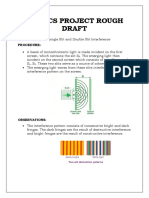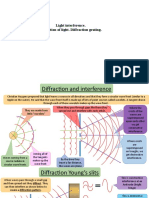Tutorial Ch27 Solution
Uploaded by
Key FuTutorial Ch27 Solution
Uploaded by
Key FuTutorial 8
Chapter 27
1. In a Young's double-slit experiment the wavelength of light used is 520 nm (in vacuum), and the
separation between the slits is 1.4 × 10-6 m. Determine the angle that locates (a) the dark fringe for
which m = 0, (b) the bright fringe for which m = 1, (c) the dark fringe for which m = 1, and (d) the
bright fringe for which m = 2.
1. REASONING The angles that determine the locations of the dark and bright fringes in a
Young’s double-slit experiment are related to the integers m that identify the fringes, the
wavelength of the light, and the separation d between the slits. Since values are given for m,
, and d, the angles can be calculated.
SOLUTION The expressions that specify in terms of m, , and d are as follows:
Bright fringes sin m m 0, 1, 2, 3, ... (27.1)
d
Dark fringes
sin m
1
2 d m 0, 1, 2, 3, ... (27.2)
Applying these expressions gives the answers that we seek.
d 520
9
10 m
a. sin m
1
or sin 1 0 12 6 11
2
1.4 10 m
520 109 m
b. sin m or sin 1 1 22
d 1.4 106 m
c.
sin m
1
2 d
or sin 1 1 12
520 109 m
34
1.4 106 m
520 109 m
d. sin m or sin 1 2 48
d 1.4 106 m
5. In a Young’s double-slit experiment, the seventh dark fringe is located 0.025 m to the side of the
central bright fringe on a flat screen, which is 1.1 m away from the slits. The separation between the
slits is 1.4 × 10-4 m. What is the wavelength of the light being used?
5. REASONING According to Equation 27.2, the Seventh
Double
wavelength of the light is related to the angle slit dark fringe
between the central bright fringe and the y
seventh dark fringe according to
Central
L
bright
AP10001 Introduction to Physics 1 Dr. S.H. Choy
d sin
m 12
where d is the separation between the slits, and m = 0, 1, 2, 3, … The first dark fringe occurs
when m = 0, so the seventh dark fringe occurs when m = 6. The distance d is given, and we can
determine the angle by using the inverse tangent function, tan 1 y / L , since both y and
L are known (see the drawing).
SOLUTION We will first compute the angle between the central bright fringe and the seventh
dark fringe using the geometry shown in the drawing:
y 0.025 m
tan 1 tan 1 1.3
L 1.1 m
The wavelength of the light is
d sin 1.4 104 m sin1.3
4.9 107 m
m 2 1 6 2
1
9. In a Young's double-slit experiment the separation distance y between the second-order bright
fringe and the central bright fringe on a flat screen is 0.0180 m, when the light has a wavelength
of 411 nm. Assume that the angles are small enough so that sin is approximately equal to tan .
Find the separation y when the light has a wavelength of 585 nm.
9. REASONING The drawing shows a top Second-order bright
view of the double slit and the screen, as Double fringe (m = 2)
slit
well as the position of the central bright
y
fringe (m = 0) and the second-order
bright fringe (m = 2). The vertical Central bright
distance y in the drawing can be obtained L fringe (m = 0)
from the tangent function as
y = L tan . According to Equation 27.1, the angle is related to the wavelength of the light
and the separation d between the slits by sin m / d , where m = 0, 1, 2, 3, … If the angle
is small, then tan sin , so that
m
y L tan L sin L
d
We will use this relation to find the value of y when = 585 nm.
SOLUTION When = 425 nm, we know that y = 0.0180 m, so
AP10001 Introduction to Physics 2 Dr. S.H. Choy
m 411 nm
0.0180 m L
d
Dividing Equation (1) by Equation (2) and algebraically eliminating the common factors of L, m, and d,
we find that
m
L
y d
0.0180 m m 411 nm 411 nm
L
d
When = 585 nm, the distance to the second-order bright fringe is
585 nm
y 0.0180 m 0.0256 m
411 nm
55. REASONING In order for the two rays to interfere constructively and thereby form a bright interference
fringe, the difference between their path lengths must be an integral multiple m of the
wavelength of the light:
m (1)
In Equation (1), m can take on any integral value (m = 0, 1, 2, 3, …). In this case, the rays meet at the
eight-order bright fringe, so we have that m = 8.
SOLUTION Solving Equation (1) for , and substituting m = 8, we obtain
4.57 106 m
5.71107 m
m 8
Using the equivalence 1 nm = 10−9 m, we convert this result to nanometers:
5.71107 m 101nm
9
571 nm
m
AP10001 Introduction to Physics 3 Dr. S.H. Choy
AP10001 Introduction to Physics 4 Dr. S.H. Choy
You might also like
- Deformations of Reinforced Concrete Members at Yielding and UltimateNo ratings yetDeformations of Reinforced Concrete Members at Yielding and Ultimate84 pages
- Today's Agenda: Review of Waves. Young's Double Slit ExperimentNo ratings yetToday's Agenda: Review of Waves. Young's Double Slit Experiment9 pages
- Physics 2nd CH 7 Udvash (English Version)No ratings yetPhysics 2nd CH 7 Udvash (English Version)22 pages
- Double Slit Interference Intensity FinalNo ratings yetDouble Slit Interference Intensity Final30 pages
- L2 Division of Wave Front, Fresnel's BiprismNo ratings yetL2 Division of Wave Front, Fresnel's Biprism24 pages
- wave and oscillations questions with solutionsNo ratings yetwave and oscillations questions with solutions9 pages
- Interference - Practiceproblems With SolutionsNo ratings yetInterference - Practiceproblems With Solutions8 pages
- physics numerical problems board exams chap- (8)No ratings yetphysics numerical problems board exams chap- (8)6 pages
- WaveInterferencePracticeProblems AnswersNo ratings yetWaveInterferencePracticeProblems Answers2 pages
- WaveInterferencePracticeProblems AnswersNo ratings yetWaveInterferencePracticeProblems Answers2 pages
- WaveInterferencePracticeProblems AnswersNo ratings yetWaveInterferencePracticeProblems Answers2 pages
- Interference and Young's Double Slit Experiment100% (1)Interference and Young's Double Slit Experiment16 pages
- Q4_GenPhysics2_USLeM4_Week4_GenPhysics2_AmielVijandre_Version3No ratings yetQ4_GenPhysics2_USLeM4_Week4_GenPhysics2_AmielVijandre_Version311 pages
- Diffraction and Interference of Light Waves - 080449No ratings yetDiffraction and Interference of Light Waves - 0804497 pages
- [L4] - (JLD 2.0) - Wave Optics - 26th NovNo ratings yet[L4] - (JLD 2.0) - Wave Optics - 26th Nov37 pages
- PHY260-CHAP5-WAVE OPTICS-M.MARYAM-200220No ratings yetPHY260-CHAP5-WAVE OPTICS-M.MARYAM-200220143 pages
- Practice Test 14 _ Test Paper (Physics) __ PDF Only __ Parishram 2025No ratings yetPractice Test 14 _ Test Paper (Physics) __ PDF Only __ Parishram 20257 pages
- The Role of Top Management Teams in Hospitals Facing Strategic Change: Effects On PerformanceNo ratings yetThe Role of Top Management Teams in Hospitals Facing Strategic Change: Effects On Performance9 pages
- The Effects of Orifice Plate Meters When Installed BackwardsNo ratings yetThe Effects of Orifice Plate Meters When Installed Backwards1 page
- Get (Ebook) Generalized Linear Models and Extensions by James W. Hardin, Joseph M. Hilbe ISBN 9781597182256, 1597182257 free all chapters100% (15)Get (Ebook) Generalized Linear Models and Extensions by James W. Hardin, Joseph M. Hilbe ISBN 9781597182256, 1597182257 free all chapters67 pages
- Derivatives of Logarithmic and Exponential FunctionsNo ratings yetDerivatives of Logarithmic and Exponential Functions4 pages
- L2 Constructing Probability DistributionNo ratings yetL2 Constructing Probability Distribution20 pages
- Standard For The Tonnage Measurement of Vessels: Second EditionNo ratings yetStandard For The Tonnage Measurement of Vessels: Second Edition57 pages
- The Application of Pairs Trading To Stock MarketsNo ratings yetThe Application of Pairs Trading To Stock Markets31 pages
- The Extraction of A Digital Surface Model (DSM) : Jun 29th, 2016 Page 1 of 18No ratings yetThe Extraction of A Digital Surface Model (DSM) : Jun 29th, 2016 Page 1 of 1818 pages
- Immediate Download Fundamentals of Graphics Using MATLAB 1st Edition Ranjan Parekh Ebooks 2024100% (4)Immediate Download Fundamentals of Graphics Using MATLAB 1st Edition Ranjan Parekh Ebooks 202462 pages
- Research Methodology: Jayant Karandikar Ex. Director, Omkar Consultech, PuneNo ratings yetResearch Methodology: Jayant Karandikar Ex. Director, Omkar Consultech, Pune17 pages
























































































